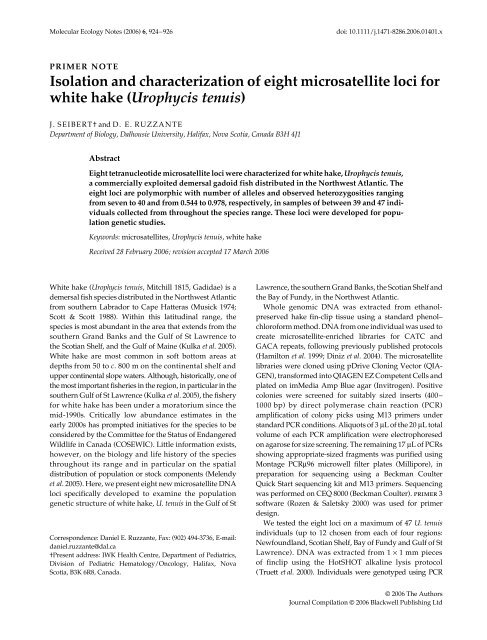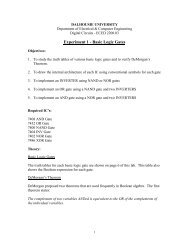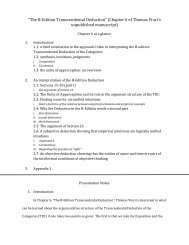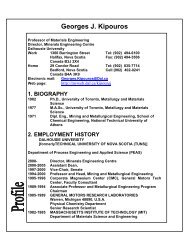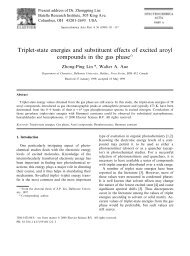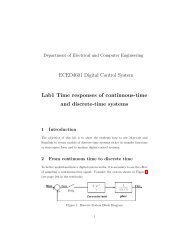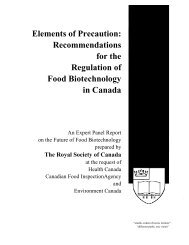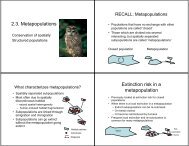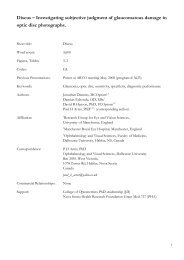Molecular Ecology Notes (2006) - Myweb.dal.ca - Dalhousie University
Molecular Ecology Notes (2006) - Myweb.dal.ca - Dalhousie University
Molecular Ecology Notes (2006) - Myweb.dal.ca - Dalhousie University
Create successful ePaper yourself
Turn your PDF publications into a flip-book with our unique Google optimized e-Paper software.
<strong>Molecular</strong> <strong>Ecology</strong> <strong>Notes</strong> (<strong>2006</strong>) 6, 924–926<br />
doi: 10.1111/j.1471-8286.<strong>2006</strong>.01401.x<br />
Blackwell Publishing Ltd<br />
PRIMER NOTE<br />
Isolation and characterization of eight microsatellite loci for<br />
white hake (Urophycis tenuis)<br />
J. SEIBERT† and D. E. RUZZANTE<br />
Department of Biology, <strong>Dalhousie</strong> <strong>University</strong>, Halifax, Nova Scotia, Canada B3H 4J1<br />
Abstract<br />
Eight tetranucleotide microsatellite loci were characterized for white hake, Urophycis tenuis,<br />
a commercially exploited demersal gadoid fish distributed in the Northwest Atlantic. The<br />
eight loci are polymorphic with number of alleles and observed heterozygosities ranging<br />
from seven to 40 and from 0.544 to 0.978, respectively, in samples of between 39 and 47 individuals<br />
collected from throughout the species range. These loci were developed for population<br />
genetic studies.<br />
Keywords: microsatellites, Urophycis tenuis, white hake<br />
Received 28 February <strong>2006</strong>; revision accepted 17 March <strong>2006</strong><br />
White hake (Urophycis tenuis, Mitchill 1815, Gadidae) is a<br />
demersal fish species distributed in the Northwest Atlantic<br />
from southern Labrador to Cape Hatteras (Musick 1974;<br />
Scott & Scott 1988). Within this latitudinal range, the<br />
species is most abundant in the area that extends from the<br />
southern Grand Banks and the Gulf of St Lawrence to<br />
the Scotian Shelf, and the Gulf of Maine (Kulka et al. 2005).<br />
White hake are most common in soft bottom areas at<br />
depths from 50 to c. 800 m on the continental shelf and<br />
upper continental slope waters. Although, histori<strong>ca</strong>lly, one of<br />
the most important fisheries in the region, in particular in the<br />
southern Gulf of St Lawrence (Kulka et al. 2005), the fishery<br />
for white hake has been under a moratorium since the<br />
mid-1990s. Criti<strong>ca</strong>lly low abundance estimates in the<br />
early 2000s has prompted initiatives for the species to be<br />
considered by the Committee for the Status of Endangered<br />
Wildlife in Canada (COSEWIC). Little information exists,<br />
however, on the biology and life history of the species<br />
throughout its range and in particular on the spatial<br />
distribution of population or stock components (Melendy<br />
et al. 2005). Here, we present eight new microsatellite DNA<br />
loci specifi<strong>ca</strong>lly developed to examine the population<br />
genetic structure of white hake, U. tenuis in the Gulf of St<br />
Correspondence: Daniel E. Ruzzante, Fax: (902) 494-3736, E-mail:<br />
daniel.ruzzante@<strong>dal</strong>.<strong>ca</strong><br />
†Present address: IWK Health Centre, Department of Pediatrics,<br />
Division of Pediatric Hematology/Oncology, Halifax, Nova<br />
Scotia, B3K 6R8, Canada.<br />
Lawrence, the southern Grand Banks, the Scotian Shelf and<br />
the Bay of Fundy, in the Northwest Atlantic.<br />
Whole genomic DNA was extracted from ethanolpreserved<br />
hake fin-clip tissue using a standard phenol–<br />
chloroform method. DNA from one individual was used to<br />
create microsatellite-enriched libraries for CATC and<br />
GACA repeats, following previously published protocols<br />
(Hamilton et al. 1999; Diniz et al. 2004). The microsatellite<br />
libraries were cloned using pDrive Cloning Vector (QIA-<br />
GEN), transformed into QIAGEN EZ Competent Cells and<br />
plated on imMedia Amp Blue agar (Invitrogen). Positive<br />
colonies were screened for suitably sized inserts (400–<br />
1000 bp) by direct polymerase chain reaction (PCR)<br />
amplifi<strong>ca</strong>tion of colony picks using M13 primers under<br />
standard PCR conditions. Aliquots of 3 µL of the 20 µL total<br />
volume of each PCR amplifi<strong>ca</strong>tion were electrophoresed<br />
on agarose for size screening. The remaining 17 µL of PCRs<br />
showing appropriate-sized fragments was purified using<br />
Montage PCRµ96 microwell filter plates (Millipore), in<br />
preparation for sequencing using a Beckman Coulter<br />
Quick Start sequencing kit and M13 primers. Sequencing<br />
was performed on CEQ 8000 (Beckman Coulter). primer 3<br />
software (Rozen & Saletsky 2000) was used for primer<br />
design.<br />
We tested the eight loci on a maximum of 47 U. tenuis<br />
individuals (up to 12 chosen from each of four regions:<br />
Newfoundland, Scotian Shelf, Bay of Fundy and Gulf of St<br />
Lawrence). DNA was extracted from 1 × 1 mm pieces<br />
of finclip using the HotSHOT alkaline lysis protocol<br />
(Truett et al. 2000). Individuals were genotyped using PCR<br />
© <strong>2006</strong> The Authors<br />
Journal Compilation © <strong>2006</strong> Blackwell Publishing Ltd
PRIMER NOTE 925<br />
Table 1 Characterization of eight polymorphic microsatellite loci for white hake (Urophycics tenuis, Mitchill 1815): T a<br />
, annealing<br />
temperature (°C); number of alleles and (sample size, N), and allele size range; H O<br />
and H E<br />
, observed and expected heterozygosities,<br />
respectively; HWE within-samples (top) and overall (bottom) P values; and GenBank Accession nos<br />
T a<br />
Locus Primer sequence (5′−3′) Repeat motif allele (bp)<br />
Size of<br />
cloned<br />
No. of alleles/<br />
sample size<br />
(N)<br />
Allele<br />
size<br />
range H O<br />
H E<br />
HWE<br />
GenBank<br />
Accession<br />
no.<br />
Ute1 F: GGGGCGATTTAGACCAAAGT (GACA) 8<br />
54 157 7 (39) 148–172 0.8810 0.7768 0.98 DQ 294931<br />
R: GTGGGTCTGTCCAGGATGTT 0.99<br />
Ute12 F: CATCCTCTCCGAACACTGGT (CTGT) 13<br />
62 190 13 (44) 166–214 0.9070 0.8947 0.42 DQ 294932<br />
R: GCAGAAGCACCGGTTACATT 0.63<br />
Ute13 F: CCCTGCACTCCCTCCTCT (CTGT) 10<br />
65 128 10 (40) 126–170 0.8750 0.8509 0.80 DQ 294933<br />
R: AGAGGGCCGGGGCTATAT 0.55<br />
Ute19 F: GTCTGCCTGCCTGTCTAT (CTGT) 14<br />
54 182 7 (46) 156–180 0.7826 0.7413 0.67 DQ 294934<br />
R: GCAAAGGAAGAGAAGAAAAA 0.65<br />
Ute22 F: CTGTTTACCTCCGCTTTTAG (CTGT) 9<br />
60.5 264 24 (45) 222–362 0.8000 0.9039 0.001 DQ 294935<br />
R: ATCACTGCAAGAGACATGAT 0.001<br />
Ute27 F: TTTGTCGGTGCACTGTTACC (GACA) 12<br />
58 195 15 (42) 158–214 0.7674 0.8577 0.011 DQ 294936<br />
R: CCGGTTCTTCGTCTTTCCAC 0.017<br />
Ute34 F: ACTGACAGACGGGTCGATG (GACA) 11<br />
68 119 9 (45) 105–130 0.5435 0.6636 0.171 DQ 294937<br />
R: ACCTGAATGCTGCTGATGTG 0.054<br />
Ute35 F: CCCGAGGGTAACTCGATTG (GACA) 12<br />
GGCA(GACA) 7<br />
58 229 40 (47) 150–460 0.9783 0.9689 0.345 DQ 294938<br />
R: CGCTATTGGAGAGGTGAAGC 0.283<br />
amplifi<strong>ca</strong>tions of 10-µL volumes containing 0.5–1 µL of<br />
extracted DNA, 2.5 mm MgCl 2<br />
, 50 µm of each dNTP, 0.5 U<br />
Taq polymerase (Sigma), 1 µm of each primer (forward<br />
primers were 5′ end-labelled with IR700 or IR800 dye) and<br />
1× PCR buffer. PCRs included: 94 °C for 3 min, followed by<br />
30 cycles at 94 °C for 45 s, primer-specific T a<br />
(Table 1) for<br />
30 s and 72 °C for 30 s. Reactions were run in MJ Research<br />
thermocyclers and imaged on a LI-COR IR2 DNA Analyser<br />
model 4200.<br />
Gels were scored by eye and with saga automated<br />
microsatellite software (LI-COR). Tests for departure<br />
from Hardy–Weinberg equilibrium (HWE) and for linkage<br />
disequilibrium were conducted with fstat version 2.9.3.2<br />
(Goudet 1995). Observed and expected heterozygosities<br />
are reported (Table 1). There was no evidence for departures<br />
from HWE (either within samples or overall) for<br />
six out of the eight loci; the exceptions being loci Ute 22<br />
(P < 0.001) and Ute 34 (P < 0.011) (Table 1). No evidence<br />
of null alleles or large allele dropout was detected<br />
when the data were analysed using micro-checker<br />
(Goudet et al. 1995). Similarly, there was no evidence of<br />
genotypic disequilibrium between any pairs of loci<br />
even before correcting for multiple tests (P > 0.1046,<br />
α (95%)<br />
= 0.0017 with 28 pairwise comparisons). Preliminary<br />
(due to small sample size) tests for population differentiation<br />
(not assuming random mating within samples, i.e. loglikelihood<br />
G-test, Goudet et al. 1995) not surprisingly<br />
indi<strong>ca</strong>ted that, though markers may differ in their ability<br />
to discriminate among (these) populations (P ≤ 0.01 to<br />
P ≤ 0.82), this ability increases when all markers are<br />
considered jointly (P ≈ 0.002). Stronger tests of markers’<br />
ability for detecting population differentiation must,<br />
however, await the scoring of further samples of mature<br />
individuals in spawning condition. Primer sequences were<br />
deposited in GenBank [(Accession nos DQ 294931–DQ<br />
294938 (Table 1)]. Although no cross-species amplifi<strong>ca</strong>tion<br />
tests were conducted with these markers, markers<br />
developed for Atlantic cod, Gadus morhua (Gmo8, Gmo19,<br />
Gmo34, Gmo37, Miller et al. 2000; Gmo2 and Gmo132,<br />
Brooker et al. 1994), and for walleye Pollock, Theragra<br />
chalcogramma (Tch5, Tch11, Tch14, Tch22; O’Reilly et al.<br />
2000), were initially tested on our samples of white hake<br />
but failed to amplify successfully.<br />
Acknowledgements<br />
Funding to DER for this research was provided by the Canadian<br />
Department of Fisheries and Oceans (DFO). The valuable advice of<br />
Ian Paterson and Friso Palstra (Gene probe Laboratory, <strong>Dalhousie</strong><br />
<strong>University</strong>) and the collection of samples by Alida Bundy, Tom<br />
Hurlbut and Dave Kulka (DFO) are gratefully acknowledged.<br />
References<br />
Brooker AL, Cook D, Bentzen P, Wright JM, Doyle RW (1994)<br />
Organization of microsatellites differs between mammals and<br />
cold-water teleost fishes. Canadian Journal of Fisheries and Aquatic<br />
Sciences, 51, 1959–1966.<br />
Diniz FM, MacLean N, Paterson IG, Bentzen P (2004) Polymorphic<br />
tetranucleotide microsatellite markers in the Caribbean spiny<br />
lobster, Panulirus argus. <strong>Molecular</strong> <strong>Ecology</strong> <strong>Notes</strong>, 4, 327–329.<br />
Goudet J (1995) fstat (version 1.2): a computer program to<br />
<strong>ca</strong>lculate F-statistics. Journal of Heredity, 86, 485–486. Software<br />
available at www2.unil.ch/popgen/softwares/fstat.htm.<br />
© <strong>2006</strong> The Authors<br />
Journal Compilation © <strong>2006</strong> Blackwell Publishing Ltd
926 PRIMER NOTE<br />
Hamilton MB, Pincus EL, DiFiore A, Fleischer RC (1999) Universal<br />
linker and ligation procedures for construction of genomic<br />
DNA libraries enriched for microsatellites. BioTechniques, 27,<br />
500–507.<br />
Kulka DW, Ciri CM, Simpson MR (2005) Distribution and aspects<br />
of life history of white hake (Urophycis tenuis, Mitchill 1815) on<br />
the Grand Banks of Newfoundland. NAFO SCR Doc. 05/60,<br />
Serial No. N5146.<br />
Melendy J, McClelland G, Hurlbut T (2005) Use of parasite tags in<br />
delineating stocks of white hake (Urophycis tenuis) from the<br />
southern Gulf of St Lawrence and Cape Breton Shelf. Fisheries<br />
Research, 76, 392–400.<br />
Miller KM, Le KD, BeachamTD (2000) Development of tri- and<br />
tetranucleotide repeat microsatellite loci in Atlantic cod (Gadus<br />
morhua). <strong>Molecular</strong> <strong>Ecology</strong>, 9, 238–239.<br />
Musick JA (1974) Seasonal distribution of sibling hakes, Urophycis<br />
chuss and U. tenuis (Pisces, Gadidae) in New England. Fishery<br />
Bulletin, US, 72, 481–495.<br />
O’Reilly PT, Canino MF, Bailey KM, Bentzen P (2000) Isolation of<br />
twenty low stutter di- and tetranucleotide microsatellites for<br />
population analyses of walleye pollock and other gadoids.<br />
Journal of Fish Biology, 56, 1074–1086.<br />
Rozen S, Skaletzky H (2000) primer 3 on the WWW for general<br />
users and for biologist programmers. In: Bioinformatics Methods<br />
and Protocols: Methods in <strong>Molecular</strong> Biology (eds Krawetz S,<br />
Misener S), pp. 365–386. Humana Press, Totowa, New Jersey.<br />
Scott WB, Scott MG (1988) Atlantic fishes of Canada. Canadian Bulletin<br />
of Fisheries and Aquatic Sciences, 219, 713.<br />
Truett GE, Heeger P, Mynatt RL, Truett AA, Walker JA, Warman<br />
ML (2000) Preparation of PCR-quality mouse genomic DNA<br />
with hot sodium hydroxide and Tris (HotSHOT). BioTechniques,<br />
29, 52–54.<br />
Van Oosterhout C, Hutchinson WF, Wills DPM, Shipley Shipley P<br />
(2004) micro-checker: software for identifying and correcting<br />
genotyping errors in microsatellite data. <strong>Molecular</strong> <strong>Ecology</strong><br />
<strong>Notes</strong>, 4, 535–538.<br />
© <strong>2006</strong> The Authors<br />
Journal Compilation © <strong>2006</strong> Blackwell Publishing Ltd


